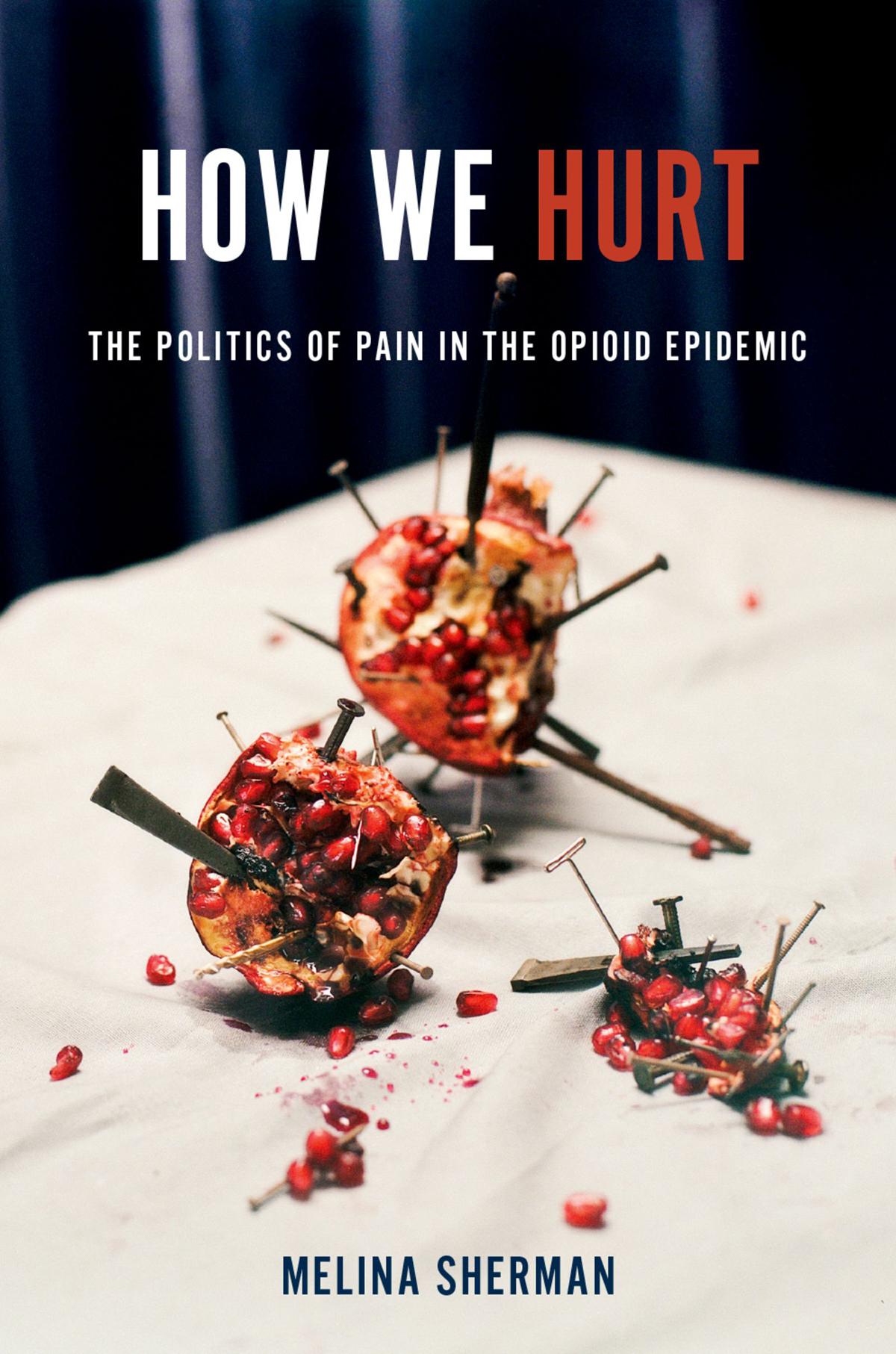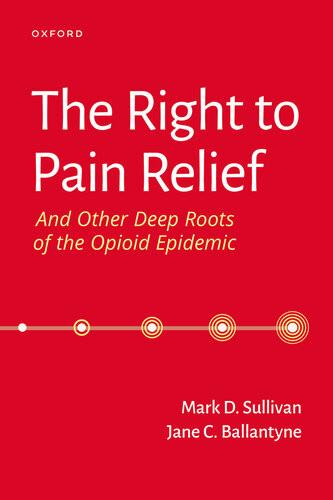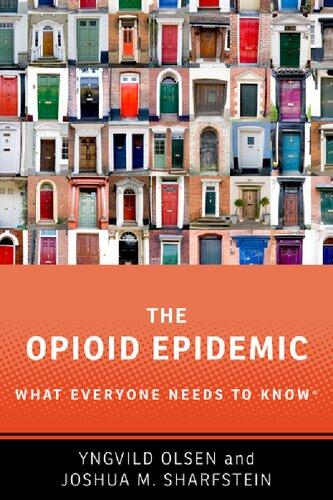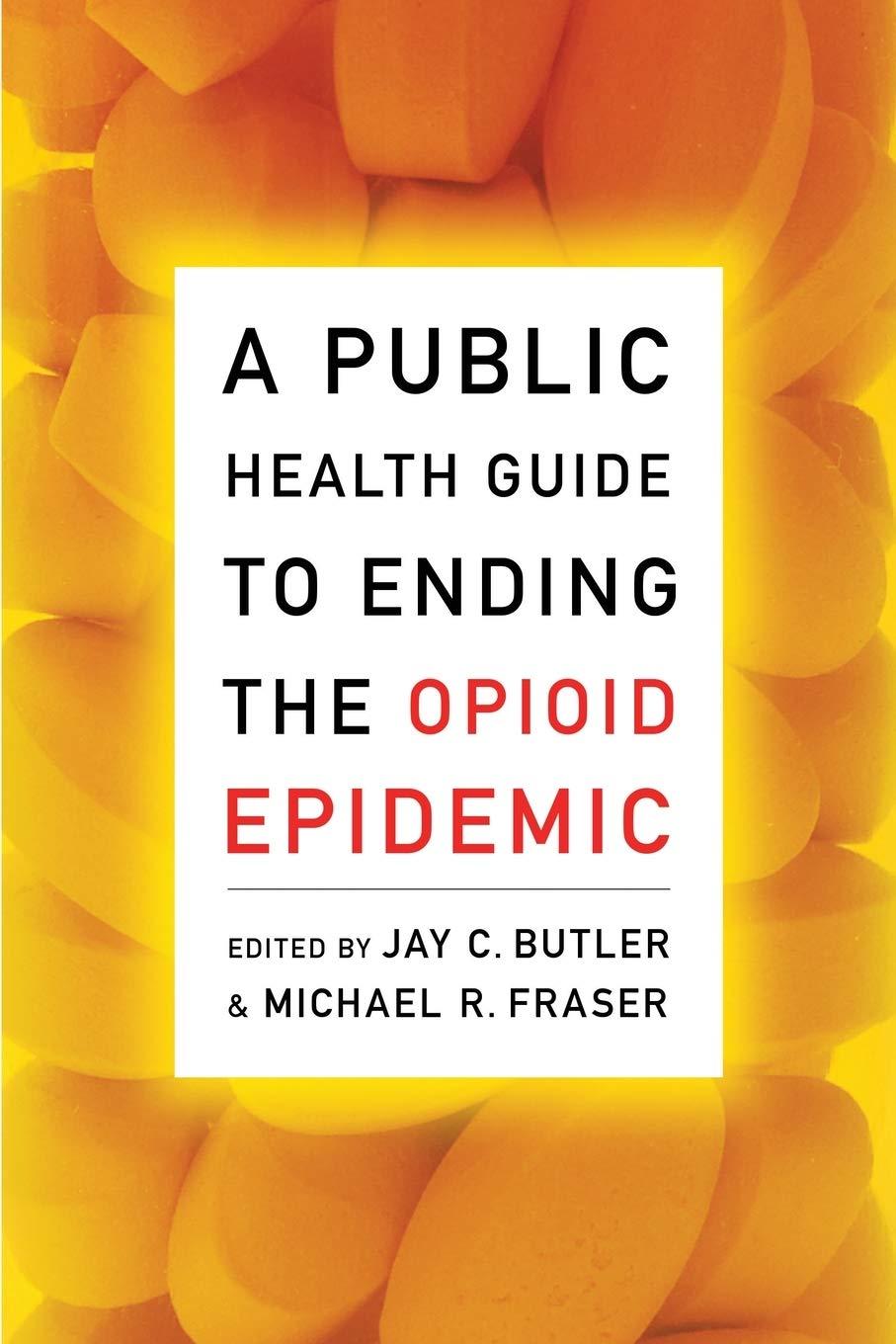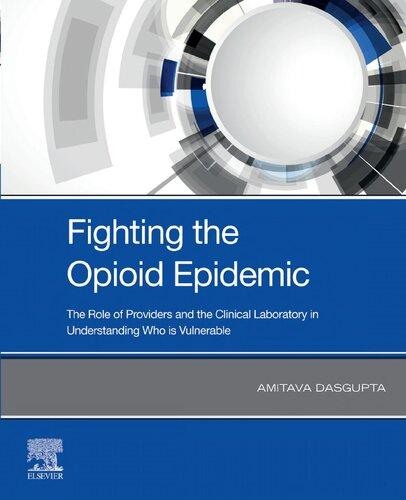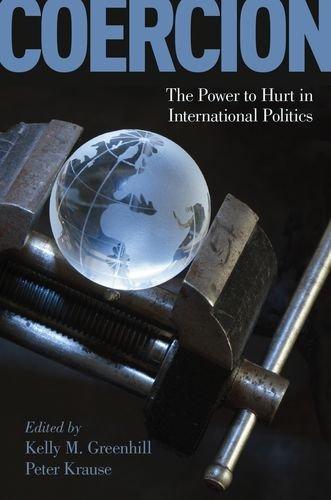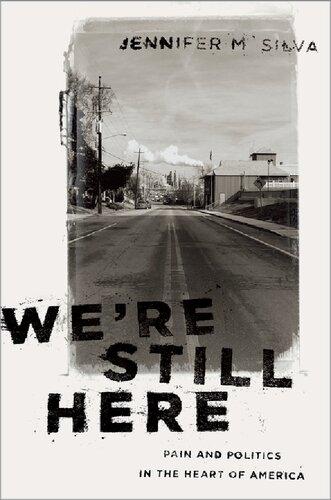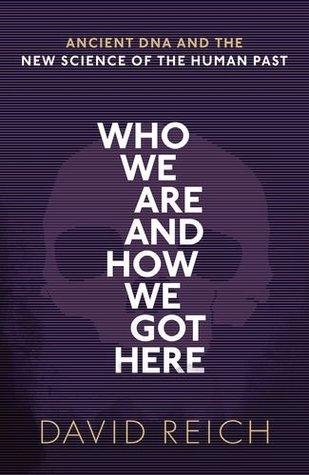How We Hurt
The Politics ofPain in the OpioidEpidemic
MELINA SHERMAN
Oxford University Press is a department of the University of Oxford. It furthers the University’s objective of excellence in research, scholarship, and education by publishing worldwide. Oxford is a registered trade mark of Oxford University Press in the UK and certain other countries.
Published in the United States of America by Oxford University Press 198 Madison Avenue, New York, NY 10016, United States of America.
© Oxford University Press 2024
All rights reserved. No part of this publication may be reproduced, stored in a retrieval system, or transmitted, in any form or by any means, without the prior permission in writing of Oxford University Press, or as expressly permitted by law, by license, or under terms agreed with the appropriate reproduction rights organization. Inquiries concerning reproduction outside the scope of the above should be sent to the Rights Department, Oxford University Press, at the address above.
You must not circulate this work in any other form and you must impose this same condition on any acquirer.
Library of Congress Cataloging-in-Publication Data
Names: Sherman, Melina, author.
Title: How we hurt : the politics of pain in the opioid epidemic / Melina Sherman. Description: New York, NY : Oxford University Press, [2024] | Includes bibliographical references and index. |
Identifiers: LCCN 2023011323 (print) | LCCN 2023011324 (ebook) | ISBN 9780197698235 (paperback) | ISBN 9780197698228 (hardback) | ISBN 9780197698259 (epub) | ISBN 9780197698266
Subjects: LCSH: Opioid abuse—United States. | Chronic pain—Treatment—United States.
Classification: LCC HV5825 .S4499 2024 (print) | LCC HV5825 (ebook) | DDC 362.29/3—dc23/eng/20230322
LC record available at https://lccn.loc.gov/2023011323
LC ebook record available at https://lccn.loc.gov/2023011324
DOI: 10.1093/oso/9780197698228.001.0001
Toallofthosewholiveinpain.
Contents
Acknowledgments
Opening
1. Tracing the Painkiller Revolution
2. Strategic Ignorance in Opioid Regulation
3. Branding Pain Relief
4. Self-Help and the Rise of the Pain Patient-Expert
5. Pain’s New Faces
Closing References Index
Acknowledgments
I did not write this book alone. Many people, in many different places around the world, helped me do it.
The first to acknowledge are the following members of my dissertation committee in Los Angeles, who read and reread this text in its earliest form and told me that it was, in fact, a book.
Patti Riley, thank you for helping me figure out how to write a dissertation as a book from the get-go. You told me that I needed to tell a compelling story, and that’s what I’ve worked hardest to try to do.
Chris Smith, we’ve had many a productive conversation in your office. There, you pushed me to think more deeply about the cultural dynamics that color the landscape of opioids and pain. I hope I did our conversations justice.
Henry Jenkins, who took me on last minute as his advisee, also shared with me that, sometimes, it’s better to ask for forgiveness rather than permission. Well, that’s what we did, and it worked!
Sarah Banet-Weiser, my advisor and friend, thank you for letting me choose this as my dissertation topic. I know it was a drastic departure from what I had initially planned to write, but you supported me, nonetheless. And even though I still don’t always believe that the rules apply to me, I won’t forget that it was you who let me spread my scholarly wings. Chapter 3 is for you, sister.
And Andy Lakoff, who was (and continues to be) a brilliant advisor and one of the smartest people I know. Your intellectual contributions are spread out all over these pages. Thank you for so many an office hour discussing Foucault’s biopolitics. I still have the notes I wrote then, and I refer to them often.
Outside of my committee, several other scholars provided me with advice and inspiration. I drew heavily on their experience and
work when developing this project. They are Marcia Meldrum, Kelly Ray Knight, Eugene Raikhel, Helena Hansen, and Emily Martin.
Aside from researching, teaching, and writing a dissertation, I was lucky enough to form many friendships in the doctoral program at the University of Southern California. From each of these friends, I collected advice and drew inspiration. Thanks for that, Andrea Wenzel, Shabnam Shalizi, Dan O’Reilly-Rowe, Anna Loup, Nathalie Maréchal, Lik Sam Chan, Katie Elder, MC Forelle, Perry Johnson, Courtney Cox, and Kristen Steves.
After graduate school (and a stint in Brazil), I moved to Manhattan to work at New York University with Eric Klinenberg, who, during my postdoctoral appointment, graciously gave me both the time and encouragement I needed to revise the manuscript. The method of social autopsy is one of several of your ideas that animates these pages, and which I believe improved the book.
I’d be remiss not to also thank my colleagues at Knology in New York City, especially Rebecca, Jena, and John. Your friendship and solidarity give me excellent reasons to get to work, and you’ve cheered me on, on the many occasions when I’ve referenced this project.
Then, I must also thank the anonymous reviewers who read and reread this text, and who made insights and suggestions that greatly improved it. And a big thank you to my editors at Oxford University Press in the United Kingdom and New York, who brought this idea to fruition.
Outside of work, Mom and Dad, my sister Marisa, and my grandparents were crucial in providing me with limitless love and support. Without them, all of this would have been but a dream. Somewhere between Barcelona and California is my dear friend Manuel Castells, who always believed in this project and urged me to keep going, even when I had decided I would never write or think again. Teloagradezco,mucho.
Here in Brazil, where I currently live, I am motivated by my two fierce stepchildren, Luiza and Rafael. Your unbridled enthusiasm for politics, history, and human rights inspires me more than you will ever know.
And finally, I owe this book to my husband, Marcelo. How many hours have you spent listening to my digressions on the politics of pain, the many meanings of health, and my hopes for the future of drug policy? You pushed me even when I was unwilling to be pushed and have been the best sounding board I could have ever asked for. Obrigada,meucompanheiro,meular,emeuamor.
Opening
In early 2018, TIME magazine published an online photojournalism series on what has become known as the U.S. “opioid epidemic.” “The Opioid Diaries” requires visitors to scroll down through a series of black-and-white photographs, each of which is accompanied by captions and quotes. In the first image, situated at the very top of the page, a man and woman are photographed crouching in the back of a van, which the caption says is parked in San Francisco. Inside it, the couple balances on their shins as they aim needles full of clear liquid at the veins they’ve found in each other’s arms. Further down the page is a pick-up truck with a man named Chad reclining in the driver’s seat. His body is lax and, although his eyes are open, his head is cocked backward so far that it nearly escapes the frame. He overdosed shortly before the picture was taken and now lies in a state of semiconsciousness as a trio of paramedics leans through the truck’s open door and try to revive him. Below Chad’s image is a photograph of two people—a elderly woman and a young man—embracing inside a funeral parlor in New Hampshire. The woman’s 24-year-old granddaughter, Michaela, can be seen in the background lying colorless and quiet inside her open casket. Scrolling down, a quote appears in large block letters on the screen; they belong to an Ohio sheriff who, commenting on what he’s seen of the opioid epidemic in his own state, says simply, “It’s nonstop. It’s every day.”
Continuing down the page, a woman in Boston squats on a mound of dirty snow. Whether because of overuse or the dropping temperature, she is struggling to find a vein. Below her, a homeless grandmother injects heroin next to a shopping cart full of her belongings. She is followed by a series of police officers. Each is accompanied by overdose victims, whose limp bodies were found on the side of the road in New Mexico, or stretched out on a bed in
Ohio, or crumpled in a heap on the kitchen floor. With every movement of the mouse, more and more photos appear on the screen, more and more people, though most of them are bodies— depictions of death found in every corner of the nation, from Massachusetts and New Hampshire to Florida, Ohio, Kentucky, and New Mexico. But finally, at the bottom of the page is an image of life a tiny baby, born just seconds before the photo was a taken. On first glance, the photograph is a hopeful one, though the quote accompanying it tells a different story. For this little girl is but one of the many children who, from the moment they enter the world, are destined “to be born addicted.” She, and the others like her, are not symbols of hope, nor of life, but of a bleak and provisional endpoint: The first book in “The Opioid Diaries” may be full, but another one sits on the shelf beside it—a stack of blank pages waiting to be filled by the next generation of corpses-in-waiting and the stories they’ll tell about a future where nothing is getting any better.
The story offered to us in the “The Opioid Diaries” not only describes a desperate reality located in the present but also lays out a nightmarish trajectory of the future—a story set in motion by the descent of so many people into the labyrinth of addiction. This dark space that, as all of the images described above suggest, is occupied by ever-expanding networks of drugs, death, and, perhaps most tellingly, of pain. The networks of pain that encompass people who use opioids, their families, as well as social workers, counselors, and police officers, among others, have been growing exponentially over the past 20 years and yet show no signs of stagnating—at least not anytime soon.
But while “The Opioid Diaries” and many other striking news stories like it point to opioid use and addiction as the key problems that define the current crisis, I disagree. I want to suggest, as this book does, that understanding opioid epidemic—what it is, how it evolved, and how it gained meaning and significance among the American population—is a story that is better told through the lens of pain. After all, it was pain and, specifically, the various moves that rendered certain pain medications legible as safe and popular drugs of choice that helped us get here in the first place. Borrowing a term
used in popular parlance, it often seems as if we’re being pushed down to “rock bottom,” while growing pain networks continue to encompass more and more of us and the people we love.
It is no stretch to say, as many already have, that the ongoing opioid epidemic represents the worst overdose crisis in modern history—one that, over the past two decades, crept slowly but surely into the lives of millions of people living in North America. The rate at which Americans and Canadians are now overdosing and dying from the use of opioid drugs is astonishing: Since 1999, U.S. overdose deaths involving opioids have quintupled, to the extent that drug overdoses now constitute the leading cause of accidental death in the United States (CDC, 2017a, 2017b, 2017c). According to the most recent CDC estimates, in 2021 alone, overdoses killed nearly 108,000 Americans—a tally that far surpasses the total number of fatalities caused by car accidents and gun violence combined (Ahmad et a., 2022). Opioids, which account for 75% of all drug overdoses, are the principal force driving up this body count.
While opioid overdoses were climbing throughout the 2000s, so too was the problem of pain. The number of pain diagnoses from 2000 to 2009 show a gradual, yet stable, increase of about 3.3% and then suddenly shot upward, marking a threefold increase from 2009 to 2010, with an even greater wave seen in chronic pain diagnoses, which escalated 4.4-fold during those same years (Murphy et al., 2017). Today, according to the CDC, more than 50 million Americans suffer from chronic pain. That’s about one-fifth of the adult population and includes 20 million people who suffer from what’s referred to as “high-impact” chronic pain, that is, pain that limits their life in such a way that they can’t perform even the most basic daily functions (Dahlhamer et al., 2018).
But looking at these parallel trends in opioids and pain, key questions remain: What kinds of social forces underpin these numbers? How did it happen that so many people in pain began seeking out, receiving, and consuming opioids? After all, opioids represent just one of many classes of pain-relieving medications, including many over-the-counter options, nonsteroidal antiinflammatory drugs (NSAIDs), nonopioid analgesics, antiepileptic
drugs (AEDs) tricyclic antidepressants (TCAs), local anesthetics (LAs), and more. How did it come to pass that opioids—the class of pain relieving drugs with the longest and perhaps most well-known history of dangerous side effects, overdose, and death—suddenly took their place in the medicine cabinets of so many people in pain? This problem of pain, which cannot be separated from the waves of opioid supply and demand, is precisely what this book seeks to understand.
The Problem of Pain
As I dug deeper into the opioid epidemic—its images, narratives, and the stories of people who take opioids as well as those who manufacture, prescribe, regulate, and police them—I realized that I couldn’t answer any of the questions I had about opioids without running into some kind of question or issue concerning pain. And in the years I spent trying to learn everything I could about these drugs—which meant sifting through decades of medical journal articles, opioid advertisements, U.S. Food and Drug Administration (FDA) meeting transcripts, court cases, congressional hearings, and drug forum threads, among other things—I kept running into institutional discussions and debates around opioids that either revolved around, questioned, or were somehow stalled in the process of trying to understand how pain works and how best to deal with it.
In medicine, for example, arguments regarding the possibilities and pitfalls of using opioids as a pain treatment were waged among those with differing approaches to the problem of how to adequately measure and treat the problem of patients’ pain. Those who saw pain as a “vital sign,” an objectively measurable object equal in importance to one’s heart rate, breathing rate, and temperature, tended to advocate on behalf of opioid-based pain interventions, while those who approached pain as a behavioral symptom of a more complex social problem were often opposed to the uptake of opioids in treating pain.
Outside of the medical domain, the problem of pain has also been a powerful tool in the cultivation of consumer demand for opioid products. For instance, consider the rapid uptake of the now notorious opioid OxyContin, which was made famous as the painkiller that jump-started the current crisis. Many have attributed this uptake to the wide-reaching and incredibly aggressive marketing campaign that its manufacturer, Purdue Pharma, launched in order to sell it. And while I certainly do not disagree, what I found in my examination of Purdue’s campaign is that the successful branding of OxyContin was better explained not in terms of the promotional claims (many of which have since been outed as lies) that were made about the drug itself, but in terms of the way in which Purdue branded the problem of pain by defining it as the antithesis of independence, self-reliance, and the American dream.
In every dimension attended to in this book which includes the evolution of opioid use in medical practice as well as in pharmaceutical marketing, opioid regulation, the history of opioid addiction, and popular culture—pain is the linchpin. In particular, the way pain has been constructed within and outside medicine is key to understanding how and why opioids became so widely prescribed in the United States. The social construction of pain is what has led us to the so-called “opioid revolution”—a phrase that has been used to discuss the rapid popularization of opioid-based treatments in medicine and their normalization in culture, more generally. On the political stage, pain has informed calls made by politicians, patients, and advocates alike to break away from the United States’ historically punitive stance toward opioid use and opt instead for a more compassionate approach to the problem. In a number of recent political speeches, pain is the affective link through which politicians accrue support and promote platforms that commit to putting an end to opioid overdose, to the misery that accompanies it, and to the escalation of drug-induced fatalities now being rendered as “deaths of despair” (Case & Deaton, 2015, 2017). Through the pathos of pain, the opioid epidemic has itself becomes legible not so much as a criminal scourge but as a national tragedy, which is continuing to evolve within American culture today.
Finally, pain is the lens that forces us to interrogate the logics, protocols, strategies, and structures that make our health system function yet that have also contributed to the current crisis. In opioid regulation, for example, drug regulators’ decision to fast-track opioids and curb rising rates of pain diagnoses was made in light of regulators’ self-expressed doubts about how to define and measure pain. This uncertainty, when combined with the United States’ dominant regulatory logic of ignoring potential risks until the moment in which they can be quantified, laid an extremely fertile ground out of which the current crisis could grow.
But to say that the opioid epidemic is more about pain than about opioid drugs is not to sideline them completely. It is instead a way of coming to see how pain and opioids became so tightly connected. Opioids, to be clear, represent a class of drugs that includes substances derived from the opium poppy (including morphine and heroin) as well as synthetic and semisynthetic drugs that act on opioid receptors in the brain.1 These include both prescription drugs such as codeine, oxycodone (OxyContin), and hydrocodone (Vicodin), as well as illicit substances such as fentanyl and its more powerful analogs, like carfentanil. Every year, millions of Americans use these drugs: In 2020, 9.5 million Americans reported misusing opioids (SAMHSA, 2020). And despite various efforts on the part of regulators and law enforcement to crack down on opioid use at local, regional, and federal levels, these numbers continue to climb. The extent to which opioids have penetrated American lives is, frankly, incredible. According to a 2016 survey released by the Kaiser Family Foundation, roughly half of all Americans said that they personally know a friend or family member with either a current or past addiction to prescription opioids (NCADD, 2016). And there are many others, no doubt, who know someone using opioids outside this sanctioned medical domain.
It is striking that opioids have come to wreak such disastrous havoc in the lives of so many people in such a short amount of time —or that in 2014, in 12 different states, the number of opioid prescriptions far outnumbered the number of people living in that
state. These numbers tell a story about a nation in pain, where one in five adults are diagnosed with a chronic pain condition, and where constant suffering, for them and many others, is the norm.
Equally startling is the fact that these drugs, which we have known for thousands of years are potent, came to occupy space on the shelves in our medicine cabinets. That is to say, it is telling how their meanings have shifted, how they have, over time, been redefined as cures rather than poisons and as first-line medications rather than dangerous “drugs.”
While the opioid epidemic is not the first overdose crisis to plague the United States, it is novel in a few important ways. The first has to do with its scale: Between 1999 and 2019, nearly half a million people died from an overdose involving an opioid (CDC, 2021)—a number that outpaces the number of American soldiers killed in battle during World War II (DVA, 2017). And it is no small thing that by the time I finish writing this introduction at the end of this particular Friday, at least 130 more people in this country will be dead, and their autopsy reports will say that it was opioids that killed them (NIDA, 2020).
Second, the opioid epidemic is unique in that it represents an overdose scourge that has involved not only illicit substances, but also legal ones—chemical compounds produced by pharmaceutical companies, regulated by the federal government, prescribed by doctors, and distributed through official channels within the U.S. healthcare industry. In many ways, as this book will argue, it is precisely the dynamics of the legal spaces in which opioids have circulated that contributed to their rapid uptake and to the eventual opioid surpluses that saturated the pharmaceutical market and caused these drugs to spill out of their legal context into illict and gray drug markets. In these unregulated or semiregulated spaces, synthetic opioids are now produced on a massive scale in laboratories, advertised through Internet platforms, and distributed through the U.S. mail system and at brick-and-motor pain clinics that now populate many of the strip malls that line this country’s streets.
The fact that shadowy gray and illicit markets are intertwined with the legal market for prescription opioids points to another key
characteristic of the current epidemic, which is the threat that its existence poses to the legitimacy of U.S. health institutions and to law enforcement agencies and regulatory administrations, all of which are now charged with intervening in a problem space that they helped to create. Put another way, the opioid epidemic sheds light on a fundamental paradox: The institutions that we would typically hold responsible for identifying solutions to this problem find themselves unable to do so. And it’s no surprise, considering that the very logics, norms, and procedures that bolster their legitimacy and define their functions have also enabled the unchecked expansion of pain networks.
An additional characteristic of the opioid epidemic is that it was framed as a problem that was overwhelmingly white. The “whiteness” of the opioid epidemic has conditioned many of the tangible ways in which the health establishment and criminal legal system have chosen to intervene in drug use and on people who use drugs (PWUD), just as it has also been a crucial component that has shaped the public discourse surrounding them. To provide one example, the construction of opioid use as a criminal issue requiring punishment and imprisonment—which was a dominant approach to the use of heroin among people of color throughout the 1980s—now exists in tension alongside other discourses, some of which advocate for a public health and human rights approach to drug use. Today, we are likely to find speeches and political positionings related to opioid use that take a “compassionate” stance toward it, opting less for incarceration than for rehabilitation. This narrative is paralleled by the construction of opioid use as an overwhelmingly white problem and as something that warrants empathy rather than punishment. Indeed, the subtexts of race and class—specifically of whiteness—are embedded in many of the discussions and protocols that have been used to intervene in the problems of pain and opioid use. Much has been made of the fact that for the first time in a generation, the life expectancy of white Americans is declining, presumably due to painkiller-related overdoses and suicides. Moreover, race and class shape the political and institutional
positions that condition the ways in which drug use is interpreted and experienced by different segments of the American population.
Pain and Uncertainty
On October 26, 2017, then President Trump signed a presidential memorandum ordering the Secretary of Health and Human Services to declare the opioid epidemic a “nationwide public health emergency” (Hirschfeld Davis, 2017; Wagner et al., 2017). But what makes a situation an emergency, or an “epidemic”? Uncertainty and unpreparedness are problems that are central to the construction of the opioid epidemic as both an epidemic and a public health emergency. We were, in many ways, unprepared for the opioid crisis. We were, for reasons that will be laid out in Chapter 2, poorly equipped to anticipate the extent of opioid use that would come in the wake of approving new opioid products. And we have since been uncertain as to how to deal with the consequences of these decisions.
And after all, what is a declaration of a “public health emergency” if not a very public manifestation of panic in the face of extreme uncertainty? In particular, the uncertainty regarding the relationship between opioids and pain is one that has long plagued medical professionals, regulators, patients, and politicians. It has dominated their various meetings and discussions, ultimately anticipating a host of hasty decisions, undergirded by weak or nonexistent knowledge (which these experts themselves admit to) about how to measure the intensity of pain, to what extent opioids can be used to treat it, how to measure their effectiveness, and how to know whether or not they pose a risk to pain patients. The discourse of uncertainty in the face of pain management, opioid development, regulation, marketing, and treatment is absolutely crucial to accurately telling the story of the opioid epidemic. It is important in part because it is a discourse that anticipates the use of particular kinds of interventions that are designed to manage it (Lak off, 2017). In the opioid crisis, interventions that have been utilized
in the face of uncertainty about a present predicament have tended to rely on historical data. And they have used that data to attempt to anticipate the evolution of the crisis. Regulators and scientific experts attempted to overcome their uncertainties regarding pain and the risks of opioids through the mobilization of two major techniques: (1) the production and promotion of new “life-saving anti-abuse” technologies and (2) surveillance, or “pharmacovigilance” techniques, explicitly designed to identify and mitigate health risks as they unfold in real time.2 Both types of intervention, which were developed and widely lauded in the name of eradicating uncertainty and ending opioid abuse, were developed relying on historical data about similar, but not identical, patterns of drug use. In doing so, they made the mistake of neglecting to incorporate the novel realities of opioid use and, as a result, had incredibly negative effects both on opioid consumption trends and on the ability of regulators and law enforcement to anticipate and manage new kinds of risks associated with opioid use.
As a public health emergency rooted in extreme uncertainty and a series of failed attempts to remedy the problem, the opioid epidemic is also a reflection of widespread public concerns and doubts regarding the promise of scientific expertise, pharmaceutical innovation, and the usefulness of our nation’s health system. As are all public health emergencies, the opioid epidemic is emblematic of many of the shortcomings of institutional expertise in dealing with seemingly unmanageable risks. It is, in Lakoff and Collier’s words, a product “of the scientific frameworks and governmental practices that seek to know and manage” it (Lakoff & Collier, 2008, p. 7).
Perhaps what the public has found, in expressing such anger and disappointment at the public health establishment and other associated actors, is their creation of and tepid response to something that Ulrich Beck (1992) referred to as “modernization risks”—risks that not only give rise to emergencies but are actually produced from within the workings of modernization itself, often by the very same institutions, knowledges, and practices that were meant to contain them. Put another way, the opioid epidemic is a
problem that did not emerge out of thin air. It should instead be understood as something that grew out of the specific knowledges, practices, and logics being applied from various domains of expertise within our health-related institutions (medicine, pharmacology, regulation, accreditation, etc.)—those same institutions that Americans have relied on for the promotion and protection of their health, comfort, and safety. In recent years, these experts and institutions have emerged as key contributors to the current crisis and, in many media accounts of the epidemic, are disparaged for their irresponsibility in failing to predict it as well as for their subsequent failure to respond to it (Frydl, 2017; Von Drehle, 2018).
One example of expert knowledge that appears to have collapsed under its own weight in the opioid crisis is the logic of medicine taken “as prescribed.” This logic, which is most often expressed as a directive in medication guides, suggests that a given medicine will work as it should so long as it is taken in the proper way—so long as patients use it “as prescribed.” By extension, when a patient takes their medicine in a way other than “as prescribed,” they are seen as having put themselves at risk and the risks are unknown. The rule of “as prescribed” has a number of key functions within the U.S. health system: First, it serves as a safety measure, which helps fulfill the FDA’s basic regulatory tenets—safety and efficacy. Second, it provides a legal logic that protects regulators, manufacturers, physicians, and pharmacists from prosecution should a patient suffer an injury or die as a result of taking their medication not “as prescribed.” Third, it provides a means of classifying individual consumers as well as their consumption behaviors: Those who take their drugs “as prescribed” are patients, and their behavior is neutrally understood as medication “use.” Those who deviate from the rule of “as prescribed” take on a different status; they are not patients but addicts, whose consumption practices are reconstrued as “abuse.”
The usefulness of the logic of “as prescribed,” which has long attempted to control and police pharmaceutical drug consumption, is breaking down. We see this in media accounts of the opioid crisis that relay the stories of patients who took opioids just as their
doctors ordered yet still overdosed and died—their loved ones saddened, confused, and uncertain about how and why this could have happened under a physician’s care. We’ve seen such stories written in bold in headlines time and time again. And we’ve seen it in the panic that corresponds to these stories and in the anxieties of professionals and the public alike, which worry that far too many patients are transforming into addicts (Calabressi, 2015). So too do we read stories that signal a sharp escalation of fear and doubt doubt that is expressed with regard to medications that have killed patients, just like a “drug,” or a poison, would do. And there are other narratives, some of which tell us that doctors are no longer doctors but drug dealers; these narratives are supplemented with news about cases launched against doctors (including the physician of the late musician Prince) whose patients died from taking their medications “as prescribed” (Deprez & Barrett, 2017; Moshtaghian & Meilhan, 2018; Pazanowski, 2018). In the opioid epidemic, we can see how “as prescribed” and “not as prescribed,” “use” and “abuse, medications and “drugs,” and other similar dichotomies are breaking down, both in media accounts of the epidemic and in the official statements made by government officials and health experts who, while not exactly admitting anything, hint that the problem is, by now, too far out of their reach.
The “Grayness” of Pain
The dissolution of familiar dichotomies or boundaries in both institutions and culture shapes the subjectivity, or selfunderstanding, of people who use opioids. As discussed in Chapter 5, the distinctions that separate “patients” from “addicts” and “at risk” people who use opioids are made and repeated (in both the mass media and in institutional discussions) precisely because of the systemic uncertainty that undergirds the opioid epidemic and the problem of pain. Over the past few decades, crucial questions and doubts about the nature and measurement of pain have given rise to questions about pain treatments, which in turn have given rise to
widespread confusion and contradictions regarding the types of people who use them.
But why do pain and pain patients seem to augment the importance of boundaries and categorizations? My provisional answer to this question is that pain is a particularly gray area. Part of pain’s grayness has to do with the fact that it is a highly subjective and heterogenous experience that has come to be understood through objective and homogenous measurement techniques—a contradiction that has made it difficult to resolve many of the questions that surround it. How do we really know whether someone is in pain? When does pain become severe enough to warrant opioid-based treatment? How can we know that pain is being adequately managed? How many people experience pain, and how do they experience it? What systems of measurement and categorization do we have in our scientific, regulatory, and legal toolkits to pose answers to these questions? In the opioid epidemic, this “grayness” is everywhere and underlies both the ways in which pain is talked about and the kinds of interventions that have been developed to deal with it.
But the grayness of pain is not new. On the contrary: These slippages and categorical breakdowns within the opioid crisis have long been central to the problem of pain. They have haunted the field of pain management for decades and have prompted it to continuously grappy with uncertainties regarding pain’s definition, measurement, and treatment. Throughout the past half-century, chronic pain experts have been engaged in the task of finding appropriate methods to objectively assess what is now broadly known to be an inherently subjective experience. Doing so, after all, has been understood as necessary both for assessing the effectiveness of opioid treatments and figuring out where to draw the line in opioid prescribing. Like scientists and medical professionals, regulators have likewise been confronted with these same questions, which they need to answer in order to assess the safety and efficacy of opioid products as well as to decide whether to approve new pain medications. The objective assessment of subjective pain has been a crucial stumbling block for the FDA,
which has often found itself paralyzed by pain’s complex reality. Moreover, the grayness that challenges scientific and regulatory experts to provide confident answers to the question of pain has amplified as opioid overdoses have continued to rise. The skyrocketing rates of overdoses related to drugs that were originally deemed to be abuse deterrent or safe have only augmented this problem, making it all the more difficult for medical practitioners, regulators, and other healthcare professionals to properly assess the benefits and risks of opioid medications.
Grayness is likewise present when one examines the opioid markets. The opioid crisis evolved in different market contexts, including one that is legal, regulated, and institutionally channeled. This legal context is imagined to be distinct from the “black market,” where the manufacture, distribution and consumption of opioids are more clearly legible as illicit. But when you have a substance like a prescription painkiller that is legally manufactured and regulated by the FDA, but that circulates as much through informal exchanges among friends and family members as it does through a physician’s written prescription and can be consumed in ways that are not “as prescribed,” how do you classify it? Is it still a medication, or is it a “drug”? How can we characterize the everyday, informal contexts in which these slippages take place?
The contexts in which medications, drugs, patients, “addicts,” people who use opioids, and other such categories are gradually breaking down constitute what I refer to as the “gray market” for painkillers. By “gray market,” I am referring to a domain that is marked by practices that trouble the traditional mechanisms of legal opioid production, distribution, and consumption. In the gray market, these mechanisms also work to undercut many of the key institutional logics of drug regulation and enforcement, such as the logic of “as prescribed.” The gray market is also amplified by those same logics that characterize opioid prescribing, marketing, and regulation. Because they do not always work the way we think they do, these logics begin to drive a rapid cycle in which uncertainties lead to dire consequences. For example, as Chapter 2 demonstrates, the doubts that regulators had about what pain is and how to
measure it and its treatment played an outsized role in the decisionmaking of regulators and other key decision makers, which ended up pushing legal opioid prescriptions into illegal or, at the very least, more shadowy domains—that is, into gray markets where the drugs that circulate are legal ones but are distributed and consumed in ways that are not, which makes them particularly difficult to regulate and control.
The emergence and growth of the opioid gray market has relied primarily on two key processes, both of which are dedicated their own chapters in this book: branding and regulation. The branding of opioids has played a decisive role in constructing their meaning as a normal part of everyday life, which has helped to render their circulation in the gray market as something that is neither purely legal nor illegal, neither medical nor criminal, but somewhere in between. The processes through which the branding of opioids familiarized and domesticated them likewise helped to transform the meaning of these drugs, from something that was previously understood as a dangerous narcotic into a first-line medical treatment and staple in medicine cabinets across the country.
Part of the steady domestication of prescription painkillers before and throughout the opioid epidemic has much to do with the way in which these drugs have been connected, in advertising, to the problem of pain. Specifically, it has to do with the fact that branding opioids relied heavily on branding pain as antithetical to the American dream. That is, pain was incorporated into opioid branding not only as a symptom but also as an enemy of self-realization and the individual pursuit of happiness and other American values. Rewriting pain in this way has gone hand-in-hand with the uptake of opioids among doctors and patients. The extensiveness of this uptake, which led to sharp increases in opioid production quotas, has resulted in a pharmaceutical market overflooded with huge amounts of opioid drugs, many of which eventually find themselves diverted into the gray market.
This inundated opioid market and the presence of these drugs in so many American households are bound up with shifts in the contexts of their circulation. Once in overwhelming supply, many of
these drugs moved out of the pharmacy and into less regulated domains. They were borrowed and gifted among family members, lent and exchanged among groups of friends. In this unregulated gray market, drugs are not “copped” on the street, nor “purchased” at a pharmacy; instead, they are exchanged in situations that are far more ambiguous in terms of their legal status.
The gray market for opioids also has implications for the people who participate in it, whose definition escapes the traditional patient/addict dichotomy. That is, if a young man with a muscle sprain borrows a few of his mother’s pain pills and either takes them himself or hands them over to a friend who has a bad toothache and no prescription, Is the friend just a friend, or is he a dealer? What kind of opioid consumer do we consider his friend? A patient? An addict? Has one of these people committed a crime? Can they be punished? Should they be? These questions are not easily answered, neither by regulators nor by lawmakers, and they are difficult to interpret in these terms.
Ultimately, the uncertainties of the gray market, as well as the link it forms between the institutional and the illicit, is reshaping the broader landscape of drug use and contributing to a corresponding crisis of legitimacy within America’s health institutions. We can see an example of how this has happened when we look at so-called “abuse-deterrent” opoioids, which regulators approved to replace older, more “addictive” pain medications. They did so, however, without understanding the effects such a change would have on the terrain of opioid use. What happened, and what the FDA either did not or could not foresee, was that opioid consumption would not be deterred so much as it would be reconfigured, by both alternative drugs and a variety of creative inventions used to deactivate the antiabuse mechanisms of their new-and-improved opioids.
In the wake of this antiabuse measure, patterns of opioid use largely shifted away from the newly formatted prescription opioids and toward more powerful (and far deadlier) synthetic opioids— namely, illicit fentanyl. Fentanyl—because of the unique characteristics of its chemical composition as well as because of the difficulties in regulating the channels through which it is
manufactured and distributed—poses a grave threat to regulators and law enforcement, whose current tactics for policing illicit drug use are ill equipped to combat such a novel phenomenon. In this case then, the FDA’s attempt to keep its products within the legal prescription drug market caused a huge and rapid slippage of opioid use toward “fentanylization” and the ever growing crisis of fentanyl overdoses that characterizes the opioid epidemic today.
Overview of the Book
This book seeks to characterize and analyze ongoing public discussions and debates about pain and opioids in the midst of the ongoing “opioid epidemic.” To do so, it draws upon a qualitative and interpretive method of analyzing texts that is broadly referred to as discourse analysis—a form of textual analysis that takes into account the purposes and effects of different types of language, how beliefs and values are communicated, and how these beliefs are generated in ways that reflect or connect to the broader social and political context in which they are espoused. In particular, this book develops a discourse analysis of the communication landscape around opioid use and attempts to link what has recently been debated in pain management, opioid regulation, and pharmaceutical branding to the broader landscape of pain in U.S. society.
The method of discourse analysis applied throughout this book’s chapters relies on the compilation of a range of cultural and institutional texts, which originate from traditional media outlets and social media campaigns as well as outlets dedicated to particular institutions, regulatory organizations, pharmaceutical companies, and advocacy group websites. These texts, together with public reports, government documents, and marketing material that discuss opioids, opioid use, and/or people in pain, can be thought of as constituting the public discourse that relates to these issues. For example, one area of public discourse on which this book focuses is the historical and ongoing struggle in the news and among physicians and regulators to distinguish opioid patients from opioid
“addicts.” In analyzing the significance of this discussion and the effects it has on people in pain, I pay attention both to the ways in which language is used to formulate these debates, and how these debates are being structured in ways that point to broader cultural tendencies and social norms around drug use, opioids, and pain.
The chapters in this book can be understood as addressing the opioid epidemic by conducting a social autopsy of it (Klinenberg, 200 2). Such a method asks, “how did we get here?,” and attempts to diagnose the key factors that have contributed to the crisis we now face. To do so, it attends specifically to the key historical processes, protocols, and institutional and marketing strategies that have transformed the problem of pain into a growing crisis of opioid overdose. The five chapters in this book show that as overdose numbers climbed, the framing of pain led to key decisions and practices that help explain how the opioid epidemic could have happened in the first place. While the first four chapters of this volume attempt to illustrate the routes through which we arrived at the present moment, the final chapter asks about meaning making in the opioid epidemic and tries to understand why the crisis looks the way it does today. It builds on the arguments advanced in the first four chapters to show how pain and the uncertainty that surrounds it have contoured the opioid epidemic and its subjects. These chapters elaborate on how uncertainty and the historical tendency to categorize good and bad people who use opioids have constructed specific roles for doctors, patients, and people who use drugs. In doing so, they also set up a framework for defining whose pain warrants attention and relief, and whose does not.
As a first step in conducting an autopsy of the opioid epidemic, this book begins by tracing the history of pain and the development of the field of pain management. Within these domains, it looks at the emergence of the “pain revolution,” a sudden shift in prescribing practices in which opioids rapidly emerged as the hallmark treatment for managing different types of pain. Before the mid-1990s, attitudes toward opioids within the medical community were reluctant at best. Physicians were wary of prescribing what they understood to be extremely potent and addictive drugs and did so sparingly, usually as
a last resort for patients suffering only the most agonizing forms of cancer-related pain. Yet, in the mid-1990s, the notion of chronic pain became an area of hot debate in pain medicine, and the idea took hold that many doctors were undertreating long-lasting pain, and that opioids were not nearly as addictive as previously thought (Meld rum, 2016). After these revelations, opioid prescriptions skyrocketed, quadrupling from 1999 to 2013.
The first chapter of this book focuses on key shifts in the medical knowledge and practices related to pain in order to understand how pain and opioids came to be linked together. In doing so, it also examines how forces outside medicine acted upon and in conjunction with medical expertise in ways that helped spark the opioid revolution. That is, policies enacted by politicians working together with pharmaceutical companies, physicians, and chronic pain advocates also worked to construct a fertile landscape in which the problem of pain would become a significant issue—not just for medicine but for society in general. Within this landscape and the movement to recognize the realities of chronic pain, pain management was reframed not only as a scientific field but also as a universal human right. The moral significance that pain management gained with its articulation in a rights-based discourse and movement was a turning point both for the field itself and for the future of opioids.
The rights-based discourse that became attached to pain provided a strong justification for a concerted push in both medicine and politics to develop new ways of measuring and treating it. The paradoxical task of objectively assessing an inherently subjective phenomenon was a serious conundrum for pain physicians. Their efforts to adequately measure pain, underlined by a movement of chronic pain sufferers, helped develop and put into general practice a new protocol that opted for an understanding of pain as the “fifth vital sign.” As a vital sign, pain became prioritized as a part of common-sense clinical practice and as something that could be quickly and adequately measured in the short span of a clinical encounter. Thus, its assessment became routine practice across a variety of medical specialties, as did its treatment. Responding to a
need to treat this now frequently diagnosed condition, opioids were quickly incorporated as an effective tool for remedying a complex, subjective, and social problem within an objective clinical encounter.
Though the genealogy of pain management points to crucial moments in the longer trajectory of the opioid epidemic, it is also the case that neither opioids nor any other pharmaceutical drug can enter the market and become a brand without first passing through the regulatory apparatus of the FDA. To that end, Chapter 2 investigates the regulatory logics that undergirded the FDA’s decision to approve the release of new opioid drugs onto the market and its subsequent decisions to leave them there, despite growing awareness of the risks associated with their use. This chapter, which focuses on the regulation of OxyContin and abuse-deterrent opioid formulations like Opana ER, shows how the FDA’s ability to anticipate and prevent the risks associated with them was undermined at nearly every step of its regulatory process, where extreme uncertainty about pain, along with strategic ignorance and an overreliance on industry alliances, rendered it blind to the lived realities of opioid use. Additionally, this chapter discusses the ways in which opioid regulation led to the formation of a gray market for opioids—a phenomenon that further debilitated the FDA’s regulatory capacities and thrust it into an evolving landscape of synthetic opioid use that it could not hope to contain.
Chapter 3 expands the diagnosis of the opioid epidemic by tracing its movement into another space—the domain of pharmaceutical branding, where opioids have undergone a social and cultural process of normalization, one that transformed them from scientific/medical objects into sellable products. It looks at the branding of pain relief through a case study of the marketing of what is today the most famous of all prescription opioids—the painkiller OxyContin and its manufacturer, Purdue Pharma. Through an analysis of dozens of print advertisements, video campaigns, and other marketing techniques that Purdue used to promote its product, this chapter shows how a medical condition was reconstrued as a national problem, one that inherently hinders individuals’ pursuit of the American dream of self-realization, autonomy, and productivity.
By tying pain to the American imagination in this way, opioids became increasingly easy to incorporate into American hospitals and households, where they were situated as familiar, domesticated objects.
This new framing of pain and opioids in American culture has likewise helped to bolster the gray market for painkillers as well as the environment of extreme uncertainty that underlies the question of pain. Within medicine and regulation, domains in which firm categories have long been employed to define and manage the world of drug use, certain boundaries and “truths” about this shadowy world have begun to erode. Narratives of the opioid epidemic are brimming with evidence of such categorical breakdowns, where patients become addicts, doctors become dealers, cures become poisons, and solutions give rise to new and greater problems. Each of these shifts in meaning reveals a crack in the larger classificatory system. And as a result, the need to reclassify and re-establish meaningful distinctions between different kinds of opioid use and people who use opioids has become all the more acute.
The fourth chapter in this volume examines the ways in which the discourses that mark the pharmaceutical branding of opioids have become integrated into and reworked in the nonpharmaceutical selfhelp industry, to which many people in pain often turn when they are attempting to stop using opioid medications. This chapter traces self-help’s entrance into pain management through theories and programs of pain “self-management” and discusses how the rise of self-help in the domain of chronic pain has also paralleled the creation of a new kind of pain patient—the pain patient-expert. In both the pharmaceutical industry and the self-help industry, pain is constructed as the antithesis to leading a good life, which itself is cast in terms of individual productivity and the ability to restore and then enhance one’s own capacities. Such a discourse, which relies on the individual person in pain as the sole “self-manager” of their symptoms, is fundamentally incompatible with the reality that pain is a deeply social phenomenon—with socially informed causes and, potentially, solutions. Pain cannot, this chapter argues, be framed as
